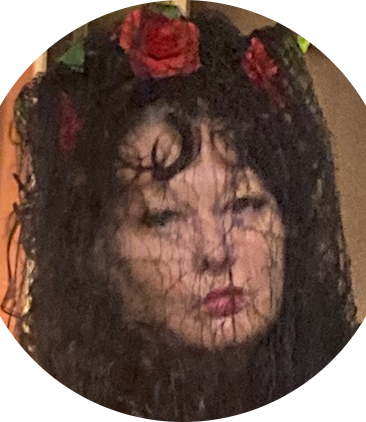WWS

WWS, or womanwithstick, is an international-award-winning and successful artist from England. Being an artist is the primary concern: “I don’t want to be seen as a person with Parkinson’s who paints. I want to be seen as an artist who happens to have Parkinson’s.”
Diagnosed in 2016, she began painting 18 months later. Recognition for her new-found talent came soon thereafter. By 2019, she became lead artist for the Oxford University research project, Picturing Parkinson’s. And by 2020, she was invited to become a house artist for a New York gallery.
Though a published poet for years, she found she needed another way to express herself once she was diagnosed.
“Sometimes, I find it easier to conceptualize how I feel in visual images, rather than the written word. Both of them have their limitations. Both of them have their possibilities and flexibilities and freedoms. When they come together. It’s wonderful.”
Whereas her poetry is a carefully disciplined craft involving a great deal of revision and close attention to structures, her art is nearly the opposite.
“I don’t sketch; I don’t draw. I haven’t got the fine motor skills for that anyway, but I pick up some paint, I pick up a canvas, and I just go where the paint takes me. And sometimes I’ll have an idea in my mind about, ‘I quite fancy capturing some kind of face at the moment,’ and it’ll turn into a seascape, and vice versa. I don’t have control over that. But I’m happy with that.”
WWS deliberately chose not to learn any rules of painting. She is self taught. She paints what she likes. She finds freedom in this approach. While her work is largely abstract, many of her paintings do have faces. And even if she’s not conscious of a face, she’s happy to corroborate the take of a viewer who sees one:
“What the artist or the writer creates is not necessarily what the receiver hears or sees or understands, because it’s a relationship where the person looking at my work will bring their own life experience to bear on it. And they will create their own narratives. And I want them to do that.”
While WWS may be new to Parkinson’s and new to painting, she is not new to art and her role as artist.
Website
Featured on TheQuiver.org
The poem and the painting are always displayed together. Indeed, they evolved together. WWS calls the painting a visual interrogation of the poem, which changed as the painting came into being. The anger expressed was born of her body’s failure to perform as it did pre-Parkinson’s, but that anger then moves into the frustrations women face in a society that similarly limits their performance. Then it grows further: “It’s also centered around this whole idea of disabled people. We’re meant to be quiet. We’re meant not to have a voice. It’s about, I suppose, anything in society where people look at you, and you’re the disadvantaged.”


